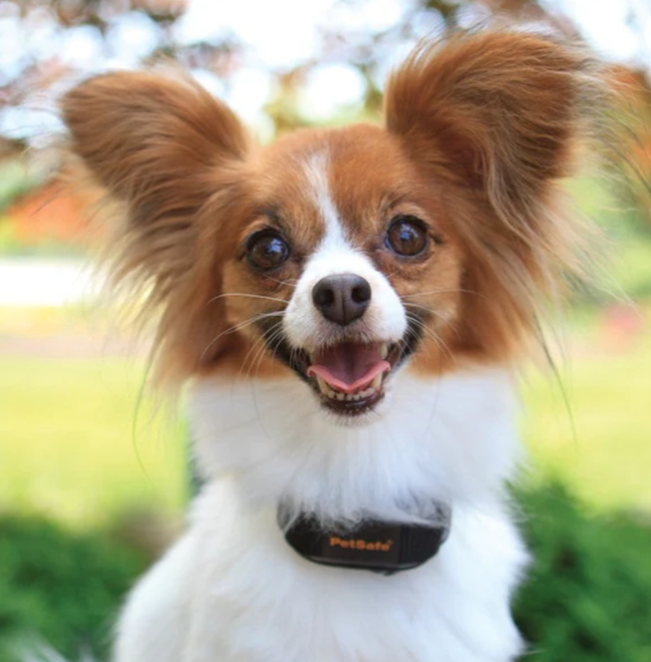If you are tired of your dog’s endless barking and if these vocal tendencies seem behavioural, then you will need an anti-bark collar. These collars function by delivering a corrective stimulus whenever your dog barks. Most bark collars automatically administer the stimulus once barking is detected, eliminating the need for constant monitoring. When on the hunt for the best option available, there is a list of important factors to consider.
Your Pooch’s Size and Personality

One of the first and most important aspects to consider when looking for the best woof control collar option is your canine’s size and personality. Excessive barking in small dogs can become a real challenge for pet owners, especially in shared living spaces or urban environments. So, control your petite canine’s uncontrolled woofing with a lightweight anti-bark dog collar for small dogs. These collars are tailored to the needs of smaller dogs, taking into account their size, sensitivity, and temperament.
A modern bark collar for small dogs uses a variety of safe methods to discourage barking. The most common types include sound, vibration, and citronella spray. These gentle deterrents help teach your dog when barking is unnecessary, without causing pain or fear. Unlike older models that may have used static shocks, today’s small dog bark collars are built with the dog’s comfort in mind and often include adjustable settings to suit your pooch’s behaviour and personality.
When picking the best anti-bark solution for a tiny dog, look for lightweight designs, soft fabrics, and adjustable straps to provide a snug, comfortable fit. Many alternatives also have clever sensors that only respond to your dog’s bark, preventing inadvertent activation by other sounds. This ensures your pet receives constant training without confusion or stress.
Additionally, when used appropriately and in conjunction with positive reinforcement training, an anti-bark dog collar for small dogs can help reduce undesired barking while keeping you and your pet happy and healthy. Before employing any bark control device, contact your veterinarian or a dog behaviourist, especially if the barking is caused by anxiety or an underlying health condition.
Manufacturers include a size and weight guide so you may be confident the collar will fit your puppy’s neck. If the collar for barking you choose fits your dog’s weight range, there’s a good chance it will fit and feel comfortable on them.
Personality should also be taken into account when choosing as you will want your puppy to learn from corrections without having their behaviour excessively corrected. As a result, a citronella collar is an excellent choice for a dog who is frightened, sensitive, or who you believe may respond negatively to static shock. It calms them down and provides just enough of a distraction to keep them from barking excessively.
In most circumstances, a static shock collar is a better option if your dog is stubborn or headstrong, or if it was rescued from an abusive home. This is a quick and simple technique to train your pet and deal with misbehaviour without putting yourself in embarrassing situations. Most breeds learn to wear static shock collars quickly.
Types
The type of bark collar you choose should respond to your dog’s needs. No bark collars have four stimulation options: static, vibration, sound, and spray.
Static bark collars are the most common among no-bark collars. These release a low-level shock once your dog’s barking is detected. It has prongs or contact points on the receiver that transmit the stimulation. Most collars offer adjustable levels of stimulation and flexible correction modes. The static type is effective as a nonstop barking solution.
A vibration anti-bark collar is a great alternative to shock collars. The collar uses sensation to prevent your dog from barking. It uses a vibrating pulse rather than static to silence the barking. Some vibration collars feature numerous stim levels, which are also adjustable. They are effective communication tools and the safest way to grab your dog’s attention, making them great for shy dogs, senior dogs, and those with hearing issues.
As their name implies, ultrasonic bark control collars use an ultrasonic or beeping sound to stop the barking. This ultrasonic sound is inaudible to humans but irritating enough for dogs. The beeping sound diverts your dog’s attention.
Ultrasonic bark collars produce a high-pitched sound that humans cannot hear. The stimulus may irritate your dog, but it has been shown to be safe and gentle on his hearing. They are a great alternative, especially for those who are unsure about using a static type.
Spray bark collars, on the other hand, work by releasing a burst of spray, either scented or unscented. The sudden spurt of mist in front of your dog’s snout distracts them from barking. The citronella or lemon spray, usually found in these collars, is harmless to your fur buddy. It’s a good option for all breeds, especially for small-sized dogs.
Intensity Level

You should also consider the intensity degree of the bark collar you’re about to purchase. Most static shock devices offer numerous intensity-level options. Some have a range of 1-10, while others have a maximum of 127. This gives you control over the amount of static shock and ensures that your dog is never hurt. Again, we recommend testing the collar on your hand’s palm to ensure that the degree of intensity is appropriate for your dog.
























